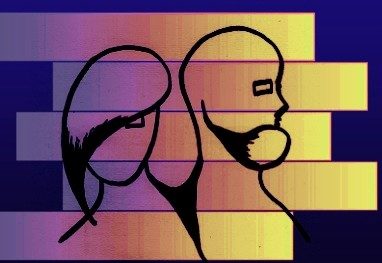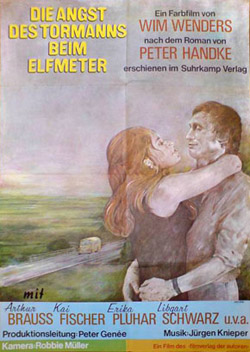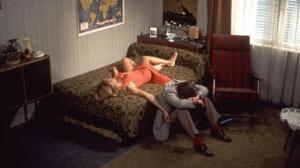Seen from the other end of the soccer field, Josef Bloch (Arthur Brauss) appears to be in control, but as all goalies are during many moments of the game, he is completely alone. But to the extent of how alone and how lonely is Josef Bloch, we will soon find out. Though we see the play is happening from a distance, Josef is a rickety mess of twitches and ticks. Eventually, the play moves towards him, and his skills should be put to the test, but do to a moment of uninspired carelessness; we soon understand how a small mistake can become the tipping point for a man on the emotional decline.
For his second feature film, Wim Wenders had decided to adapt the novel by Peter Handke, a book that remains as one of the best analogies for sport defining human emotions. Tragically, the mistake that Josef makes on the pitch precipitates a series of events that transpire in a way that some would look at as soulless, but when you take a closer look, Josef is coming apart with a blinding silent rage. You see, Josef’s mistake does not end on the field; his blunder is carried with him to Vienna where he goes to a film, listens to some Roy Orbison at a bar, meets a nice girl who takes him home; they make love; she makes him breakfast, and then he strangles her, which on the surface does not impact him a bit, but as the viewer we are inexplicably drawn to his character. Josef passively keeps track of the investigation of the death of his victim, and as a viewer we soon fear that other murders may occur, but we feel more concerned about the moment when Josef’s disconnected façade will begin to show the cracks.
“Anxiety at the Penalty Kick” is a meticulous film of small movements and dialog. At times, one would even think that they are watching an Aki Kaurismaki film, as “Anxiety” even possesses the mandatory jukebox scene in the midst of the all of the disaffected gestures, but absent is the humor that lies underneath the saddest moments of Kaurismaki’s work. Josef is also not the silent murderess Iiris, of Kaurismaki’s film “The Match Factory Girl, who saunters around her life of infinite sadness, getting by with her bleak job and horrible family to eventually commit an act of defiant freedom. Here, our Josef has lashed out, but Wenders does not frame his crime with any clear motive except that Josef wanted to commit the act. We imagine that the inspiration of this act might be the pressures of sport, but perhaps we are just seeing behavior that is more like Meursault, the protagonist of Camus’ “The Stranger.” There will be more actions that cannot be explained throughout this film, and Wenders wants your imagination to figure out why.
A Short Scene from “The Goalie’s Anxiety at the Penalty Kick”
Though a low budget production, Wenders is aided for the second time by the soon to be legendary cinematographer, Robbie Muller, who usually keeps his distance from our central figure as the viewer would in real life, but at times pulls in to see what we fear the most, a hollowed out shell of a human that has no regard for those around him. Mueller correctly pulls back in several scenes when we begin to feel that Josef is connecting, giving us the false hope of a moment that is warm in nature but cold and distant in reality. The camera is static for every shot, and, with that, it amplifies the passive nature of Josef’s idiosyncratic inner being. “Anxiety,” though striking in its composition, does not possess the eerie beauty that exists in Wenders and Muller’s greatest collaboration, 1976’s “Im Lauf der Zeit” (Kings of the Road), nor is it an elegy on the passing of eras. Instead, it is a hard look at a modern world, where the Josefs are not the melodramatic villains of Hitchcock’s mind but the villains of a non-communicative world that allows them to slip in and out without notice.


